Column stands: varieties, selection and do-it-yourself production

The speaker system allows you to get high-quality sound, but in order to fully reveal its potential and avoid imbalance in sound reproduction, it is necessary to additionally install special stands. They will allow not only to place all the elements of the system at a certain height, but also to eliminate vibration from the cabinet, making the sound more spacious, bright and clear. These devices can be either purchased ready-made or made independently from scrap materials.
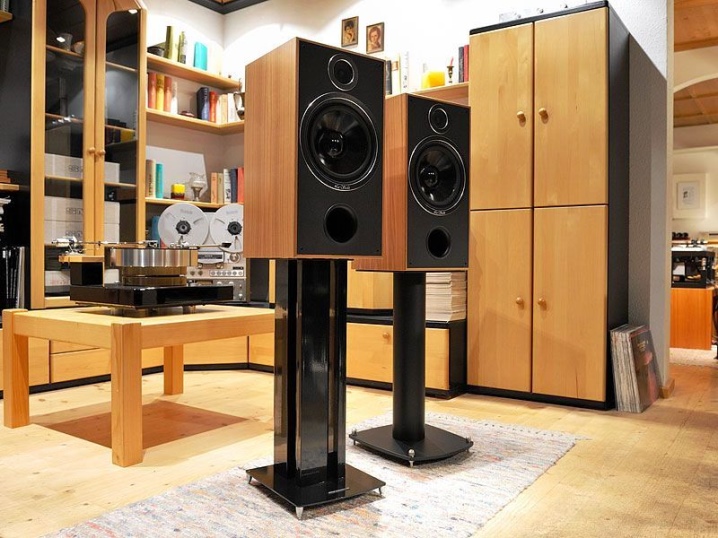
Peculiarities
The speaker stand is a special rigid and reliable structure that acts as a support for the constituent elements of the speaker system. It has a low natural resonance frequency and is made of various materials, most often acrylic, glass, MDF, metal and wood.
The main feature of acoustics stands is that they are hollow. This is done so that in the future the cavity can be filled with shot or sand, which will make it possible to obtain an absolutely inert support.
In addition, rubber gaskets or metal spikes are installed in the upper and lower plates, which contributes to high-quality vibration isolation, the cable channel is made hidden for convenience.
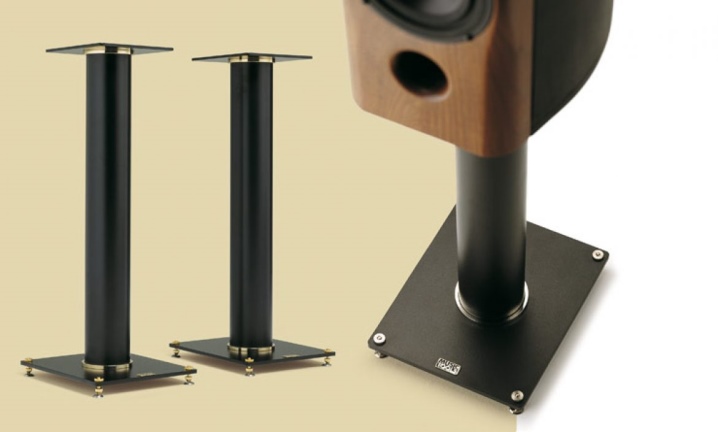
Views
Today the market is represented by a huge assortment of speaker accessories, among which speaker stands are in particular demand. They may differ from each other not only in the material of manufacture, design, but also in size, installation location (floor, suspended).

Looks great in modern design stand made of woodplaced on the floor. Models made from a combination of several materials are also considered interesting. As for the dimensions, the racks are produced both for small, medium-sized speaker systems (their height is up to 80 cm), and for large speakers with a height of 20 to 60 cm.
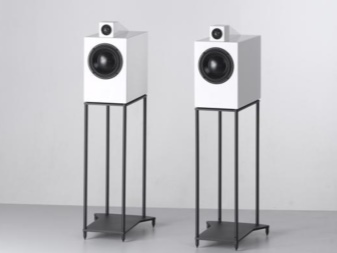
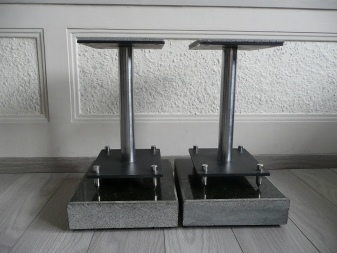
By material of manufacture
Since the column stands are a vertical support (base-support), they are made from a wide variety of materials. For example, most often on sale you can find models in which the rack is made of metal and supplemented with a glass shelf. The quality of a product is determined by the performance characteristics of the material from which it is made.
- Metal... It has a solid appearance and high strength. This material is considered the most popular, so it is often chosen by manufacturers to create racks.
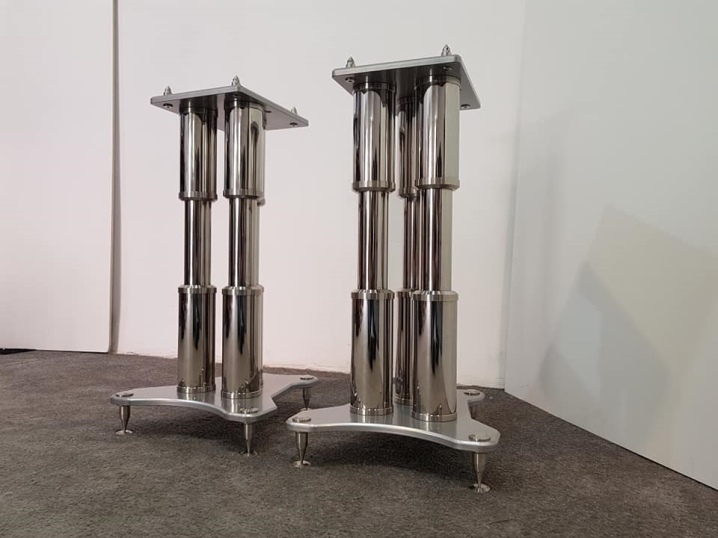
- Wood... It is a high-quality material that reliably serves for a long time, but is expensive. An alternative to natural wood is MDF, which is a medium density fiberboard.
Wood and MDF stands are capable of smoothing out individual frequencies, providing a "cohesive" and even sound.

- Metal and wood... This combination can be presented in different variations: in some models, the rack is made of metal, and the base is made of wood, while others are produced simultaneously in two versions (metal and wood).
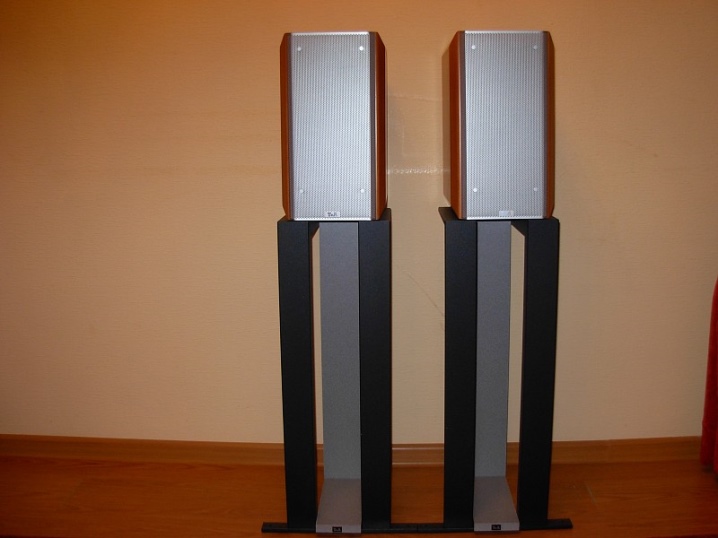
- Glass and metal... In such racks, the base is usually made of glass, and the support is made of metal. In this case, only tempered glass is used, since it is capable of withstanding significant loads.
Such models belong to the premium class, they are distinguished by their aesthetic appearance and decent acoustic characteristics.
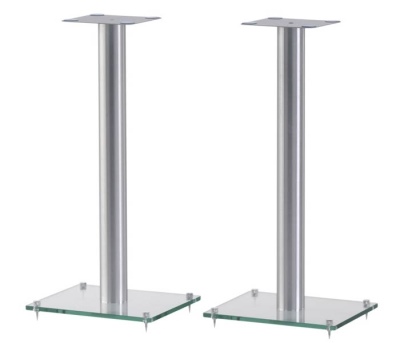
- Plastic... This material is generally chosen for floor stands because it is not suitable for wall mounting. Plastic is not a durable material, so it is usually supplemented with metal parts to ensure reliability.

In addition, speaker stands may differ not only in the material of the case, but also in the filler. Expensive models are supplemented with all kinds of gels and powders, budget ones do not have one.
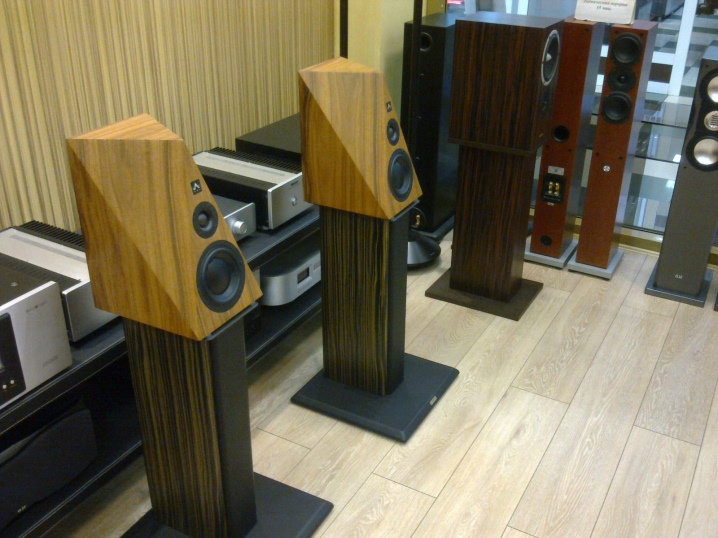
Height
To ensure that the speaker is above ear level when listening, the speakers must be placed on stands of a certain height. For mounting an acoustic center in a home theater, options with the considered parameter from 20 to 60 cm are excellent; they are placed in the room in such a way that the speakers are at a height not exceeding 1/3 of the height of the room. Compact samples need to be installed on racks from 60 to 80 cm.For rear speakers, it is recommended to purchase models with a height of 30 to 50 cm.
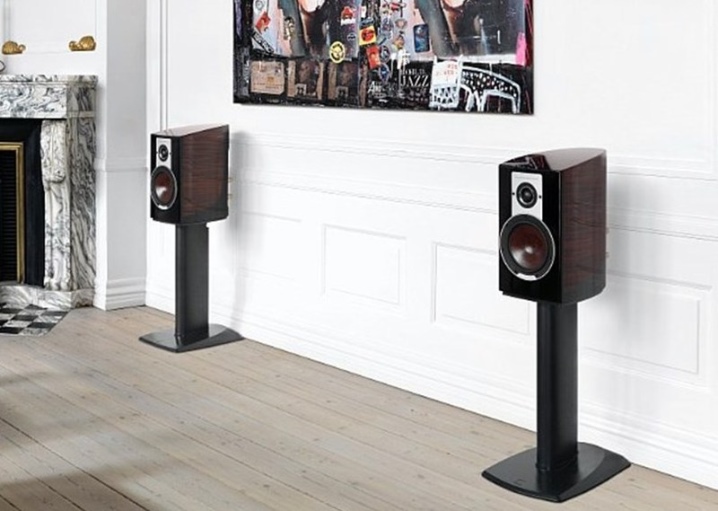
By design
When buying one or another model of stands for speakers, it is important to take into account not only its performance characteristics, but also its appearance, since the product must harmoniously fit into the overall interior of the room. Black products are considered the most versatile, as they look great in any style direction..

Models in which decorative finishes are made of natural wood, artificial stone and colored glass are also very popular, while carving and forging elements can often be found on such racks.
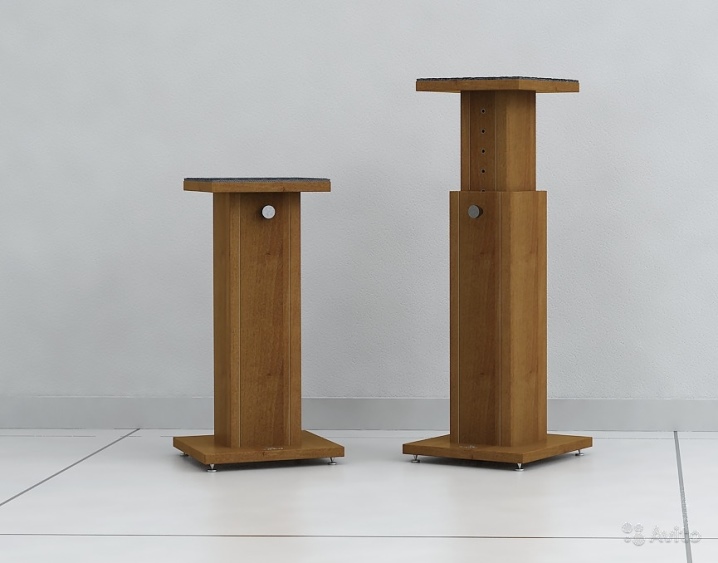
For living rooms decorated in a modern style, polished aluminum racks of unusual shapes are considered a good choice, they are installed on a labradoride base. For connoisseurs of the classics, manufacturers produce products of regular geometric shapes from different types of wood, they are additionally coated with a special varnish.

Criterias of choice
Going to buy stands for a speaker system, it is important to take into account many nuances, since the duration of their operation will depend on the correct choice.
- Finishing option... Today, manufacturers offer various models of PVC racks, which are decorated with attractive designs and patterns. If we consider products in terms of quality, then it is best to give preference to options made of fine wood and varnished or stained. No less gorgeous will look in the interior of the premises and racks made of acrylic, glass or plastic, they are cheaper, but do not have high strength.

- Construction type... To install the rear and front speakers, ordinary stands are suitable, for the central shelf you need to buy a special stand separately. It differs from standard models in its elongated width and is equipped with a wide platform.

- Place of installation... If you plan to install the speaker system on walls, then you need to choose racks with wall mountings. They are produced complete with screws and clamps, sometimes brackets are also found.
For spacious rooms, you can purchase floor stands, they take up more space, but they look chic, acting as one of the decorative elements in the interior.
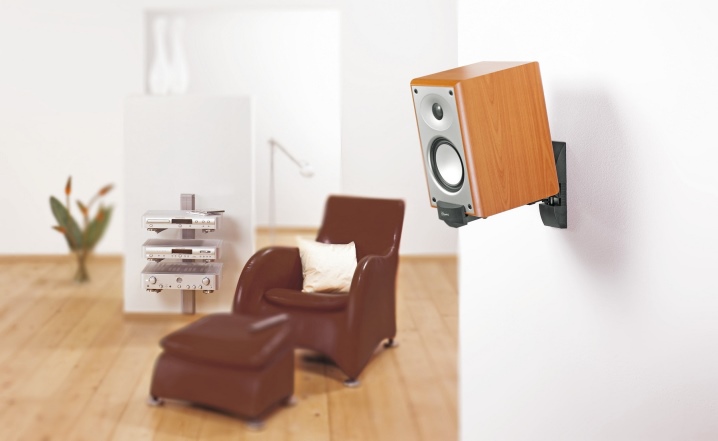
- Appointment... Home models are well suited for speaker use in restaurants, cafes, small halls and the home. They are designed for lightweight and compact speakers. For professional acoustics, which are used at concerts, stands are required that can withstand speakers of large weight and size.
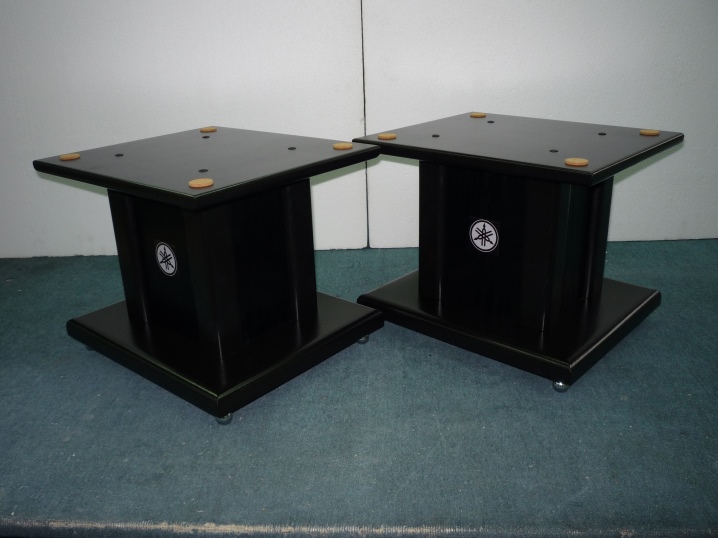
- The presence of acoustic spikes... Thanks to such elements, the contact area of the base with the floor is reduced, since they act as "legs". The spiked models provide high-quality sound because the vibration transmitted to the floor through the stand is reduced.

- Availability of adjustment... It is very important that the column is provided with a change in the angle of rotation of the speaker, while the stand must remain in the standard position. As a rule, wall-mounted models are complemented by such an adjustment. The height adjustment of the racks is also considered important.
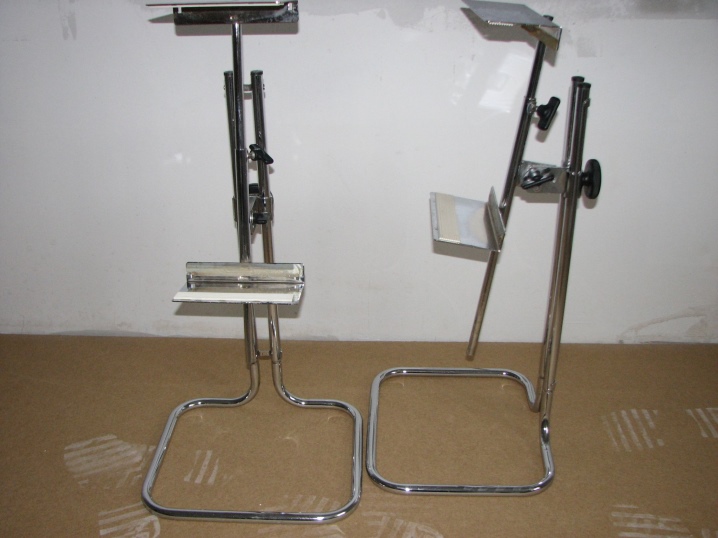
- Laying wires... It is advisable to choose models that have the ability to hide wires. There is a special recess in their design. Thanks to this, the acoustics looks neat and the risk of injury is reduced (wires can be touched and dropped).
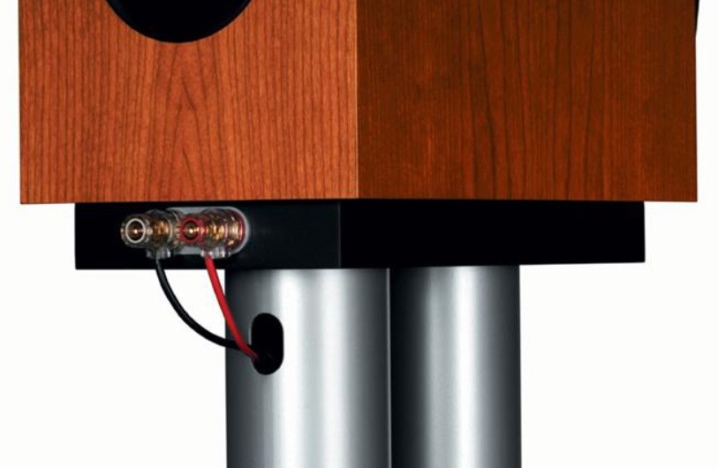
- Maximum load... The stand must reliably support the weight of the speaker, so this parameter is important to take into account when the stand is purchased separately from the acoustics and is not intended for a specific model.
It is impossible to increase the load on your own, since the rack in this case may break at any time.
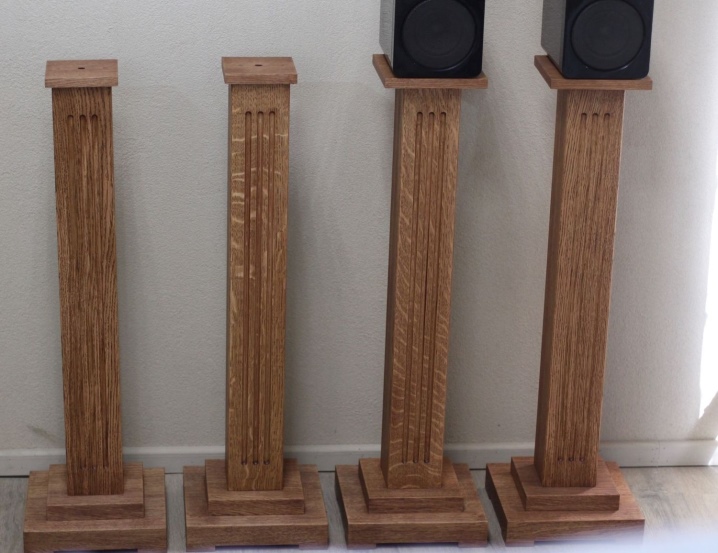
- The weight... Manufacturers indicate this parameter on boxes for products. The total weight of the rack and each item is prescribed separately. Do not choose too heavy structures, considering that their large weight will help reduce extraneous vibrations. Many models are now available with lightweight bodies.
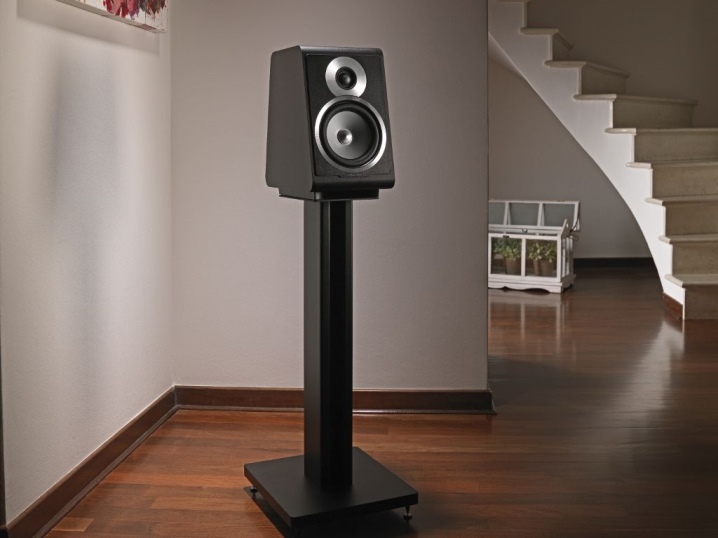
How to do it yourself?
Stands for speakers can be bought ready-made, but it will be much cheaper to make them with your own hands, while home-made structures will be in no way inferior in quality and will fit into any room design in an original way.
Before making a stand for acoustics, you will need to prepare the following materials and tools:
- a sheet of solid wood or chipboard (you will need to cut 4 parts);
- stainless steel support (can be made from a pipe with a diameter of 60 mm);
- fasteners;
- spray paint;
- screwdriver (electric screwdriver);
- drill for wood.
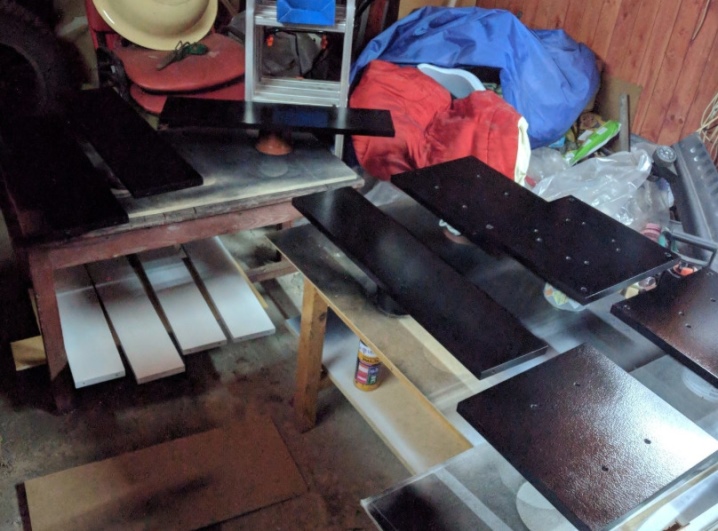
After that, a sketch is prepared on paper and a diagram of the placement of acoustics in the room. The pipe must be cut to size. If a kit with plastic plugs was purchased, then they must be pulled out. This is necessary for the subsequent fastening. The tube is pushed onto a special stand and fixed with a screw. Then you should cut a leaf of wood into 4 parts, two of which will be larger, since they will act as the base, and two smaller (they will serve as shelves).
The size of the shelves is selected in accordance with the cross-section of the speakers, excluding the part that protrudes slightly forward. This will give the legs and columns a complete look.
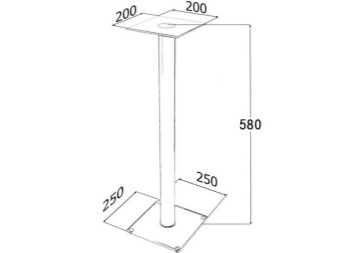

The next step is to process all the details. Since the racks are made of natural wood, it is best to choose a matte black paint for coating the material (when painting with a spray can, you need to apply the paint in three layers). It will perfectly match the texture of the array. You can also apply bold film of any color.
If the racks are assembled from chipboard, then it is recommended to cover it with varnish or stain, after which you will have to wait for the surface to dry for at least two hours.
Then it is necessary to attach the flanges to the resulting shelves and bases using self-tapping screws. To do this, pre-drill holes with a diameter of 1.5 to 2 mm. Fastening of the fundamental parts is carried out with a slight backward displacement (not exactly in the middle). It remains to insert into the mounting legs, fix everything and check the connections for evenness.

After that, you need to attach felt pads to the bases, they are usually glued to the legs of chairs and tables so as not to scratch the flooring. For racks, such pads are needed to prevent the transmission of sound frequencies to the floor. If desired, felt pads can be replaced with special thorn legs.

Besides, speaker stands can be made of thick stainless steel, from which you can assemble a rectangular column. The front panel will be wider to secure the weld seams. The size of the platform will be 30 * 30 cm, and the thickness will be 10 mm. Separately, you will need to drill holes in the plate for filling in shot or calcined sand.
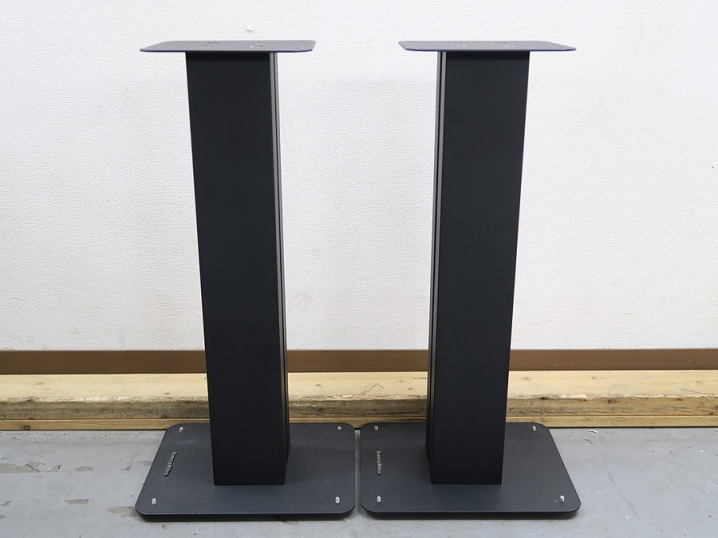
In the next video, you will learn how to make a stand for acoustics with your own hands.













The comment was sent successfully.